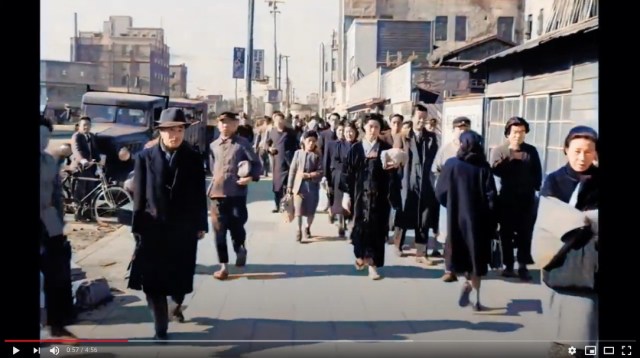
Originally used as the background for Humphrey Bogart’s close-up, these Japanese folks are now having their time in the spotlight.
It’s always fascinating to go back in time and look at footage of old Japan, and now that we’ve got access to advanced digital technology, life as it was in the past has the ability to look crisper and sharper than it ever has before.
One old clip that resurfaced recently is a perfect example, showing how much of a difference colour can add to a previously black-and-white film. And this isn’t just any ordinary film — it’s footage taken for the 1949 Hollywood movie Tokyo Joe, starring American actor Humphrey Bogart as the titular character.
▼ Take a look at the original black-and-white clip here:
Tokyo Joe was the first movie company permitted to film in Japan after World War II. It’s amazing to think that the footage above was captured in 1948, during Japan’s Showa Period (1926-1989), just three short years after the atomic bombings of Hiroshima and Nagasaki in 1945.
▼ The streets above were used as background scenery for Bogart’s character in the movie.
A blend of kimonos, suits, and soldier’s uniforms can be seen during these street scenes, reflecting the changing times of the period. In 1948, Japan was emerging from almost a century of Imperial rule, which ended when the Emperor surrendered to The Supreme Commander for the Allied Powers, General Douglas MacArthur, in 1945.
The street scenes act as a far more engaging lesson in history than anything you’d find in a textbook, and even more so when it’s been retouched in brilliant colour.
▼ Take a look at the beautiful colourised version below:
The colourised clip was created with AI technology, specifically a program called DeOldify, which uses deep learning to colourise and restore old images and videos. The difference between the two clips is remarkable, with the colourised version drawing us in to the scene in a much more meaningful way, making us feel as if this could be a real place that exists today.
While the classic cars and street signs are amazing to look at, the fashions on the street are equally mesmerising.
▼ A particularly handsome couple.
Looking at the street signs, we can see that the clip was shot in Shibuya, with signs for 道玄坂百貨街 (“Dogenzaka Department Store”) and カワシマ帽子店 (“Kawashima Hat Store”) revealing this was taken in the Dogenzaka area, specifically where Shibuya Prime stands today, next to the famous 109 building.
▼ Google Maps doesn’t go back to 1948, unfortunately, but the now-closed Hooters was housed in the Prime Building until recently.
Bogart himself didn’t actually come to Japan to film the scenes at Shibuya, with a stand-in hopping into the real “Tokyo Cycle-car”, which turns the corner at Sakae Dori, outside what is now the 109 building.
While Bogart was the original star of Tokyo Joe, 72 years later, it’s the background scenes that have stolen the limelight with their mesmerising view of everyday life in Tokyo in the late ’40s. It’s a very different Shibuya to the one we know today, with its bright lights, huge screens and busy scramble crossing, but it’s nice to see that even back then it was a hive of activity, with tightly cramped stores and fashionable pedestrians walking the streets.
And just three years after this footage was taken, the build-up of Shibuya as a city within a city really began, with the introduction of a sightseeing cable car above what is now Shibuya Station.
Source: YouTube/pcmeister11 via Japaaan
Featured image: YouTube/pcmeister11
Insert images: YouTube/pcmeister11, YouTube/LindafulLinda
● Want to hear about SoraNews24’s latest articles as soon as they’re published? Follow us on Facebook and Twitter!